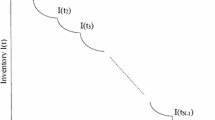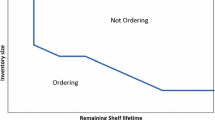Abstract
In this study, we address the joint inventory and quality management in a Cournot duopoly, for a seasonally produced, perishable product whose quality deteriorates over time. The sales of the product occur over two periods, namely the season (first period) and the off-season (second period). Apart from the stocking quantities for the two periods, firms must decide the quality levels of the units to stock for the second selling period. Firms incur a cost to maintain particular quality levels. The equilibrium policies of the firms are characterized, and we discuss the impact of the firms’ quality costs on their inventory and quality decisions. We identify the conditions of the quality costs when competition ceases to exist in the second period, and analyse the impact of the quality costs on inter-temporal price fluctuations and product availability. Using the unconstrained equilibrium policy, we frame the firms’ inventory disposal policies when production yields are exogenous.



Similar content being viewed by others
References
Akkerman R, Farahanim P and Grunow M (2010). Quality, safety and sustainability in food distribution: A review of quantitative operations management approaches and challenges. OR Spectrum 32 (4): 863–904.
Anjos MF, Cheng RCH and Currie CSM (2005). Optimal pricing policies for perishable products. European Journal of Operational Research 166 (1): 246–254.
Balasubramanian S and Bhardwaj P (2004). When not all conflict is bad: Manufacturing-marketing conflict and strategic incentive design. Management Science 50 (4): 489–502.
Banker RD, Khosla I and Sinha KK (1998). Quality and competition. Management Science 44 (9): 1179–1192.
Bertsekas DP (2005). Dynamic Programming and Optimal Control. Belmont, MA: Athena Scientific.
Bitran G, Caldentey R and Mondschein S (1998). Coordinating clearance markdown sales of seasonal products in retail chains. Operations Research 46 (5): 609–624.
Bitran GR and Mondschein SV (1997). Periodic pricing in of seasonal products retailing. Management Science 43 (1): 64–79.
Boyd S and Vandenberghe L (2012). Convex Optimization. Cambridge: Cambridge University Press.
Boyette MD, Wilson LG and Estes EA (2014). Postharvest cooling and handling of apples, http://www.bae.ncsu.edu/programs/extension/publicat/postharv/ag-413-1, accessed 9 April 2015.
Brewster JL (2008). Onions and Other Vegetable Alliums. Wallingford, UK: CAB International.
Cai X, Chen J, Xiao Y and Xu X (2010). Optimization and coordination of fresh product supply chains with freshness-keeping effort. Production and Operations Management 19 (3): 261–278.
Celestine A (2012). How Agra became India’s cold storage hub and what impact it has on price of potatoes, http://articles.economictimes.indiatimes.com/2012-08-12/news/33154080_1_cold-storage-potatoes-vegetable-prices, accessed 6 April 2015.
Chan LMA, Shen ZJM, Simchi-Levi D and Swann JL (2004). Coordination of pricing and inventory decisions: A survey and classification. In: Simchi-Levi D, Wu SD and Shen ZJ (eds). Handbook of Quantitative Supply Chain Analysis: Modeling in the E-Business Era (International Series in Operations Research & Management Science). US: Springer, pp 335–392.
Chew EP, Lee C and Liu R (2009). Joint inventory allocation and pricing decisions for perishable products. International Journal of Production Economics 120 (1): 139–150.
Elmaghraby W and Keskinocak P (2003). Dynamic pricing in the presence of inventory considerations: Research overview, current practices, and future directions. Management Science 49 (10): 1287–1309.
Feng Y and Gallego G (1995). Optimal starting times for end-of-season sales and optimal stopping times for promotional fares. Management Science 41 (8): 1371–1391.
Gallego G and Hu M (2014). Dynamic pricing of perishable assets under competition. Management Science 60 (5): 1241–1259.
Gallego G and van Ryzin GJ (1994). Optimal dynamic pricing of inventories with stochastic demand over finite horizons. Management Science 40 (8): 999–1020.
Granot D, Granot F and Mantin B (2006). Revenue management of perishable products under competition. Arbeitspapier. Sauder School of Business, University of British Columbia, Vancouver.
Huh WT and Lall U (2013). Optimal crop choice, irrigation allocation, and the impact of contract farming. Production and Operations Management 22 (5): 1126–1143.
Jesse EV (1973). Structure of Seasonal Supply and Demand in the Onion Market. Market Research Report No. 987, Economic Research Service, U.S. Department of Agriculture.
Kamal N (2015). Potato prices crash, Rampura farmers look for cold storage, http://timesofindia.indiatimes.com/india/Potato-prices-crash-Rampura-farmers-look-for-cold-storage/articleshow/46740296.cms, accessed 16 April 2015.
Levin Y, McGill J and Nediak M (2009). Dynamic pricing in the presence of strategic consumers and oligopolistic competition. Management Science 55 (1): 32–46.
Levin Y, McGill J and Nediak M (2010). Optimal dynamic pricing of perishable items by a monopolist facing strategic consumers. Production and Operations Management 19 (1): 40–60.
Lin KY and Sibdari SY (2009). Dynamic price competition with discrete customer choices. European Journal of Operational Research 197 (3): 969–980.
Liu Q and Zhang D (2013). Dynamic pricing competition with strategic customers under vertical product differentiation. Management Science 59 (1): 84–101.
Lowe TJ and Preckel PV (2004). Decision technologies for agribusiness problems: A brief review of selected literature and a call for research. Manufacturing & Service Operations Management 6 (3): 201–208.
Lucas MT and Chhajed D (2004). Applications of location analysis in agriculture: A survey. Journal of the Operational Research Society 55 (6): 561–578.
Mattheis J (2015). Maximizing postharvest quality of Gala and Fuji apples, http://postharvest.tfrec.wsu.edu/pages/PC98N, accessed 9 April 2015.
Mitra S, Mookherjee D, Torero M and Visaria S (2013). Asymmetric information and middleman margins: An experiment with West Bengal potato farmers. Tech. Rep, https://ideas.repec.org/p/ess/wpaper/id5545.html, accessed 16 April 2015.
Pal D (1991). Cournot duopoly with two production periods and cost differentials. Journal of Economic Theory 55 (2): 441–448.
Perakis G and Sood A (2006). Competitive multi-period pricing for perishable products: A robust optimization approach. Mathematical Programming 107 (1–2): 295–335.
Plà LM, Sandars DL and Higgins AJ (2013). A perspective on operational research prospects for agriculture. Journal of the Operational Research Society 65 (7): 1078–1089.
Saloner G (1987). Cournot duopoly with two production periods. Journal of Economic Theory 42 (1): 183–187.
Sinha V (2013). Why onion prices are inching towards rs. 100 per kg, available at, http://profit.ndtv.com/news/cheat-sheet/article-why-onion-prices-are-inching-towards-rs-100-per-kg-37013, accessed 29 December 2013.
Statistics New Zealand (2014). Fresh fruit and vegetable prices – Our global connection, http://www.stats.govt.nz/tools_and_services/newsletters/price-index-news/jan-14-fruit-and-vege.aspx, accessed 15 April 2015.
Xu X and Hopp WJ (2006). A monopolistic and oligopolistic stochastic flow revenue management model. Operations Research 54 (6): 1098–1109.
Yang J and Xia Y (2013). A nonatomic-game approach to dynamic pricing under competition. Production and Operations Management 22 (1): 88–103.
Acknowledgements
The authors are grateful to the anonymous referees, the editor, and the associate editor for their valuable comments. The second author gratefully acknowledges the funding support received from the AIRBUS Group Endowed Chair for Sourcing and Supply Management at the Indian Institute of Management Bangalore for this research.
Author information
Authors and Affiliations
Corresponding author
Additional information
Supplementary information accompanies this paper on the Journal of the Operational Research Society website (www.palgrave-journals.com/jors)
Electronic supplementary material
Rights and permissions
About this article
Cite this article
Chintapalli, P., Hazra, J. Stocking and quality decisions for deteriorating perishable products under competition. J Oper Res Soc 67, 593–603 (2016). https://doi.org/10.1057/jors.2015.80
Received:
Accepted:
Published:
Issue Date:
DOI: https://doi.org/10.1057/jors.2015.80




